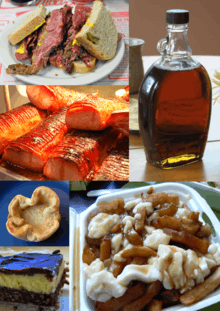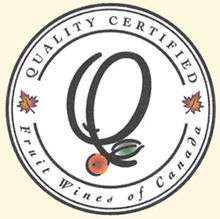Ontario wine
 |
| Part of a series on |
| Canadian cuisine |
|---|
|
Regional cuisines |
|
Religious & ethnic |
|

Ontario wine is Canadian wine produced in the province of Ontario that is certified by VQA Ontario. Wines made from 100% Ontario grapes can qualify for classification under Ontario's appellation system, the Vintners Quality Alliance (VQA), and must be certified by the provincial wine authority to use the descriptor "Ontario wine" and other regulated labelling terms. VQA regulates production standards including grape varietals, wine-making techniques employed, and other requirements and ensures label integrity for consumers. This has raised some issues with certain wineries that do not meet the VQA standard or are not eligible because they use Ontario grown winter-hardy hybrid grapes that are not recognized by VQA despite lobbying attempts to update their list of acceptable grape varieties.
Not all wines produced in Ontario are classified as VQA. Many wineries produce both VQA wines and non-VQA wines depending on their business objectives. Wines which are not labelled VQA may not meet the VQA standards, certification or verification requirements, or may be wines that are blended with imported grape content. Certain producers (grandfathered under the 1988 Canada-United States Free Trade Agreement) are permitted to produce wines from a blend of foreign grapes or wine and domestic content to produce a wine labelled as Cellared in Canada or International/Canadian Blend. Some in the wine industry are concerned about this practice.
Wines made from Ontario grapes that are not VQA certified are typically wines made using grape varieties, techniques or blends that VQA Ontario does not recognize and are not eligible for certification. Some wineries may choose not to have eligible wines certified by VQA for economic reasons or wines may have failed to pass the certification process. Wines made from fruits other than grapes, including ciders, and wines made from raw materials other than fruit such as Sake and mead are not eligible for VQA certification. The Ontario government provides support to wineries producing VQA wines through mark-up relief for VQA wines sold to restaurants and other establishments licensed to sell alcoholic beverages in Ontario.
Climate
Southern Ontario is in roughly the same latitude as southern France (Provence and the Languedoc). These regions have a tradition of growing tender fruit such as apricots and peaches, and has the growing conditions to consistently ripen many varieties of vitis vinifera grapes.
Grapegrowing in Ontario has its challenges, particularly outside of the southern regions normally associated with tender fruits. At times, wine regions in Ontario suffer from harsh winters which can damage tender vines. In addition, its humid summers can increase the pressure from fungal diseases. However, experience and advancement in technology in recent decades have led to the development of vineyard management techniques (for example, the use of wind machines in vineyards), variety selection and winemaking techniques to meet these challenges. Ontario vineyards and wineries now produce world-class wines in the table wine, Icewine and sparkling wine categories.
Varieties and styles
The most prominent varieties of grapes grown in Ontario are:
For red wine and rosé production:
- Cabernet Franc
- Merlot
- Pinot noir
- Gamay noir
- Cabernet Sauvignon
- Syrah
- Marechal Foch
- Baco noir
- Petit Verdot
- Malbec
- Zweigelt
For whites:
- Riesling
- Chardonnay
- Pinot gris
- Pinot Grigio
- Gewürztraminer
- Viognier
- Sauvignon blanc
- Semillon
- Pinot blanc
- Vidal
- Kerner
- Muscat Ottonel
For Icewines and late harvest dessert wines:
- Vidal blanc
- Riesling
- Cabernet Franc
- Cabernet Sauvignon
Growing regions
There are three official growing regions in the province recognized and regulated by the VQA.
The Niagara Peninsula, with the most area under vine and a series of recognized sub-appellations, is Canada's largest wine growing region and is blessed by a unique micro-climate facilitated by the interaction of the Niagara Escarpment and Lake Ontario.
In the Niagara Peninsula there are ten sub-appellations which each have unique growing conditions suited to different grape varieties. They are: Niagara River, Niagara Lakeshore, Four Mile Creek, St David's Bench, Creek Shores, Lincoln Lakeshore, Short Hills Bench, Twenty Mile Bench, Beamsville Bench, and Vinemount Ridge.
In addition, two regional appellations have been created: Niagara Escarpment for the bench area west of St Catharines (Short Hills Bench, Twenty Mile Bench, Beamsville Bench) and Niagara-on-the-Lake for the four sub-appellations east of St Catharines.
The north shore of Lake Erie is more southerly and receives many growing degree days, although Lake Erie freezes over in the winter. The Lake Erie North Shore appellation contains one sub-appellation, the South Islands, which includes Canada's southernmost vineyards on Pelee Island, for Canada's largest estate winery, Pelee Island Winery.
In addition Prince Edward County was created as a new growing region in 2007. Some see the future of wine in "the county" in premium wines produced from Pinot noir and Chardonnay.
There have been ongoing smaller scale attempts to grow wine in other, cooler, areas of the province using cold hardy, often hybrid grape varieties. Such is the case of Bruce County which encompasses the northern portion of the Niagara Escarpment which also runs through the Niagara wine growing region and Norfolk County along the shore of Lake Erie just west of Hamilton. Wines made in these emerging regions may be certified as VQA wines under the regional designation "Ontario".
Fruit wine

Ontario is also home to wineries specializing in fruit wine. These wines are outside the scope of the VQA, but Fruit Wines of Canada has developed the Quality Certified (QC) mark to identify quality Canadian fruit wine that is not made from grapes. Ontario-grown fruits used to make these wines include (but are not limited to) apple, apricot, black currant, blackberry, blueberry, cherry, cranberry, elderberry, gooseberry, huckleberry, haskap, nectarine, peach, pear, plum, red currant, raspberry, saskatoon berry, and strawberry.
Some fruit wineries carry other products that are not made from fruit, including wines made from rhubarb, maple syrup, and honey.
Occasionally fruit wines are combined with grape wine, mead, or other fruit wines to produce unique flavour combinations.
In some cases, these wines can include other ingredients such as chocolate (e.g. in cherry or blueberry wines) or spices (e.g. in apple wines).
Sake
Sake began to be commercially produced on a craft scale in Ontario in 2011. While sake's production methodology and product shelf life are similar to those of beer, its typical alcohol content of 12-19% by volume more closely resembles that of wine made from grapes. Ontario has an advantageous location to produce sake due to the abundant availability of high quality spring water and the large and growing size of its local market for Japanese cuisine. Sake's popularity is also increasing due to its gluten-free and sulfite-free characteristics.
See also
References
Ontario VQA Act, 1999 Ontario Regulation 406 Winemaking regulation
External links
- Map of Ontario Wineries
- Grape Growers of Ontario
- Ontario Wine Producers Association
- Ontario Wine Society
- VQA Ontario - Ontario's Wine Authority